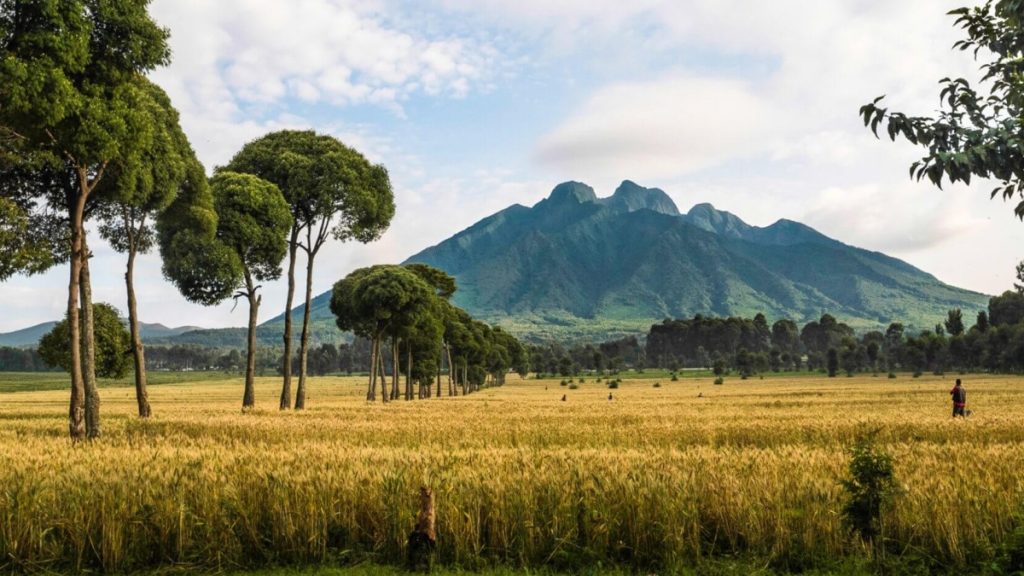Are you planning your visit to the Land of a Thousand Hills’ main destination – Volcanoes National Park but looking for some of the facts about it? This article is written to satisfy your curiosities.
The Volcanoes is a national park located in northwestern Rwanda, renowned for its breathtaking scenery, rich biodiversity, and its significance as one of the last refuges of the endangered mountain gorillas.
With a total surface area of 160 square kilometers, the Volcanoes National Park Rwanda encompasses different vegetation types and five of the eight volcanoes in the Virunga Mountains, namely; Karisimbi, Bisoke, Muhabura, Gahinga, and Sabyinyo. The park borders Virunga National Park of the Democratic Republic of Congo and Mgahinga Gorilla National Park of Uganda.
Besides mountain gorillas, the Volcanoes Park is also home to golden monkeys, several bird species, and was the base for the primatologist – Dian Fossey. Here are the top 10 facts about Volcanoes National Park:
Accessibility
Volcanoes National Park is easily accessible from Rwanda’s capital, Kigali, making it a popular destination for both domestic and international tourists. The park’s proximity to other attractions like Lake Kivu and Akagera National Park further adds to its appeal.
Gorilla Conservation
The Volcanoes National Park is one of the four last remaining sanctuaries of the critically endangered mountain gorillas. It’s home to about a third of the world’s population of these majestic primates that are seen during gorilla trekking safaris in Rwanda. The activity is done by tourists that own a trekking permit obtained from the Rwanda Development Board at USD 1,500 each.
Other destinations where the experience takes place include Bwindi & Mgahinga Gorilla National Parks of Uganda and Virunga National Park of the Democratic Republic of Congo.
Historical Significance
Volcanoes National Park was the base for Dian Fossey’s ground-breaking research on mountain gorillas. Her work played a crucial role in gorilla conservation efforts and was immortalized in the book “Gorillas in the Mist” and the subsequent film. Today, tourists can participate in the Dian Fossey hike to honor this primatologist.
The park also have a rich history in regard to President Kagame’s rise to power. It was in the forests of Volcanoes national park where he hid during the guerilla war against the tribal Rwandan regime.
Biodiversity
Apart from mountain gorillas, the park is also home to golden monkeys, which are another rare primate species. The park boasts a diverse array of other wildlife, including numerous bird species and small mammals.
Birds to spot include the red-faced woodland warbler, Ruwenzori double-collared sunbird, collared Apalis, Ruwenzori turaco, handsome francolin, and strange weaver, among others.
Volcanic Landscape
The park is dominated by five of the eight volcanoes of the Virunga Mountains, which are part of the larger Albertine Rift. These volcanoes form a stunning backdrop to the park’s scenery, including Karisimbi, Bisoke, Muhabura, Gahinga, and Sabyinyo. Different gorilla families can be seen on these mountains, such as the Amahoro family, Susa family, Karisimbi family, Sabyinyo family, Agashya family, Umubano family, Kwitonda family, and Hirwa family.
Additionally, you can see golden monkeys in the bamboo trees, twin lakes of Burera and Ruhondo, and numerous bird species like the Archer’s ground robin, red-faced woodland warbler, and Ruwenzori double-collared sunbird.
Mount Karisimbi
Volcanoes National Park encompasses the tallest volcano in the Virunga range, which is also the fifth highest mountain on the African continent. The mountain, Karisimbi, stands at a height of 4,507 meters (14,787 feet) above sea level and is known for providing a challenging but rewarding hiking adventure.
Mount Karisimbi is one of the mountains in East Africa that can be hiked within two days.
Trekking
One of the main attractions of Volcanoes National Park is gorilla trekking, where visitors can hike through the dense forest to observe and interact with habituated gorilla families in their natural habitat at a close distance.
Gorilla trekking requires every trekker to possess a permit which goes for $1500 for foreign none residents.
Cultural Encounters
The park offers opportunities for cultural experiences with the local communities, including visits to traditional villages like Gorilla Guardian Village for performances and interactions with the indigenous people. At the village, visitors can even have the chance to stand as a day queen or king of the village.
These cultural encounters will also introduce you to rehabilitated poachers. One of the things that have supported conservation in Volcanoes national park is the rehabilitation of poachers which in the long run has brought forth good results. For over two decades, no poaching incident has been recorded in Volcanoes national park.
Conservation Efforts
Volcanoes National Park is managed by the Rwanda Development Board (RDB), which works tirelessly to protect the park’s ecosystems and wildlife while also promoting sustainable tourism initiatives.
In their conservation efforts, the introduced a policy of revenue sharing with the communities that surround the national park to ensure that communities see the direct benefit of conserving Volcanoes national park.
Scenic Beauty
The park’s lush, green landscapes, mist-covered hills, and bamboo forests create a stunning backdrop for wildlife viewing and outdoor activities. Many people have found Volcanoes national park a better gorilla trekking location because it gives clearer views of the gorillas than the thick impenetrable forest
By understanding these key facts about Volcanoes National Park, you can better appreciate its significance and ensure a memorable visit to this extraordinary natural wonder.




